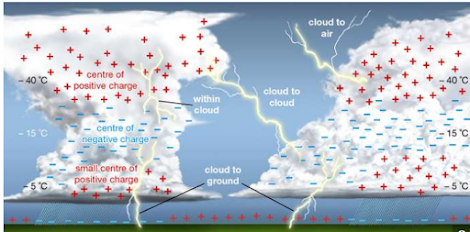Do you sometimes wonder why we often see lightening flashes first before we hear the sound of thunder? What is the science behind it and how can you protect yourself from being struck by lightening? Find out these answers and more below.
Lightening flashes and associated thunder does occur when our atmosphere attains instability. This means that the factors surrounding our atmosphere will swift from the normal level and either increases or decreases rapidly. During thunderstorms, the atmosphere becomes unstable due to the increase in air pressure, humidity, charge particles, cloud imbalances etc, this will thus trigger the actions of lightening sparks and thunder strikes.The science behind lightening
Lightening is a very powerful electrical discharge in our atmosphere caused when the imbalance of charge particles between clouds and other regions tries to equalize themselves generating millions of voltage capable to breakthrough the resistance of air. The action will then produce a visible spark reaching over five miles (eight kilometers) in length and raising the temperature of air up to 60, 000 degrees Fahrenheit(33, 400 degrees Celsius), that's 6 times hotter than the surface of the sun.
The phenomenon of lightening is really due to the concept of static electricity where unlike charges tend to attract each other and like charges repel.When the atmosphere and clouds becomes saturated with moisture, the particles of rain, ice, or snow inside the clouds begin colliding and bumping into each other, this collision will then cause a static electricity between them and often positive charge particles will move to the top of the cloud while negatively particles will settle in the bottom of the cloud.
This charge indifference will accumulate up to a point that they start demonstrating an attractive force between each other, since there is no conductive path for current to flow, the voltage(or charge indifference) will accumulate until it supersedes the resistance of air and electric current is then forced to conduct through air and thus creates an electric arc or what we call lightening. Objects on the ground, like trees, skyscrapers, power towers, telephone mass, and the Earth itself, becomes positively charged and will also attract the negatively charge particles from either the cloud or air and join in the game.
What causes the sound of thunder
Thunder is not a phenomenon of it own, but it caused by lightening. When lightening occurs, it will generate an enormous amount of heat into the air, one hotter than the surface of the sun. This will cause the air in the lightening channel to compress to a huge amount increasing it normal atmospheric pressure up to 10-100 times. As the air now then tries to expand from compression into it normal state, it does so at a supersonic speed, forcing itself out of the channel, which ultimately produces a loud sound, heard as thunder. Just like when you inflate a balloon, you're in fact increasing the air pressure inside balloon, and when you pop it, air is force out of the balloon, producing sound. Thunder just does so in a large scale.
So we can see from our explanation that since lightening causes thunder, it just a situation of normality for us to see lightening first before thunder. I personally don't accept with some common assumptions that we do see lightening before thunder due to the fact that light travels faster than sound. It is thus true that the speed of light is greater than sound, but putting matters into perspective we can see that this has absolutely nothing to do with speed here or how light travels, it's just not possible for the thunder, which is caused by lightning, to be heard first before the lightning.
One more myth about thunder is the fact that thunder is completely harmless because it just a sound. This is also practically not so true. While the action of thunder involves the production of loud sounds, thunder is not just about the sound produced. The sound of thunder if it loud enough and at a close range, can damage the ears and may cause temporary deafness.
Most importantly, thunder is produced by a sudden expansion of air from a lightening bolt. The air is thus released at a supersonic speed raising it pressure up to 100 times more than normal. If produce at a very close proximity, the extreme shock wave cause by it is capable of blowing a human off the ground, causing property damage etc. Windows and glass materials have been the most vulnerable substances during the action of thunder in my area. And lastly, the internal shock and fear you perceive during a sudden and an unexpected thunder strike can lead you to astray to running directionless into a dangerous object.




















0 comments:
Post a Comment